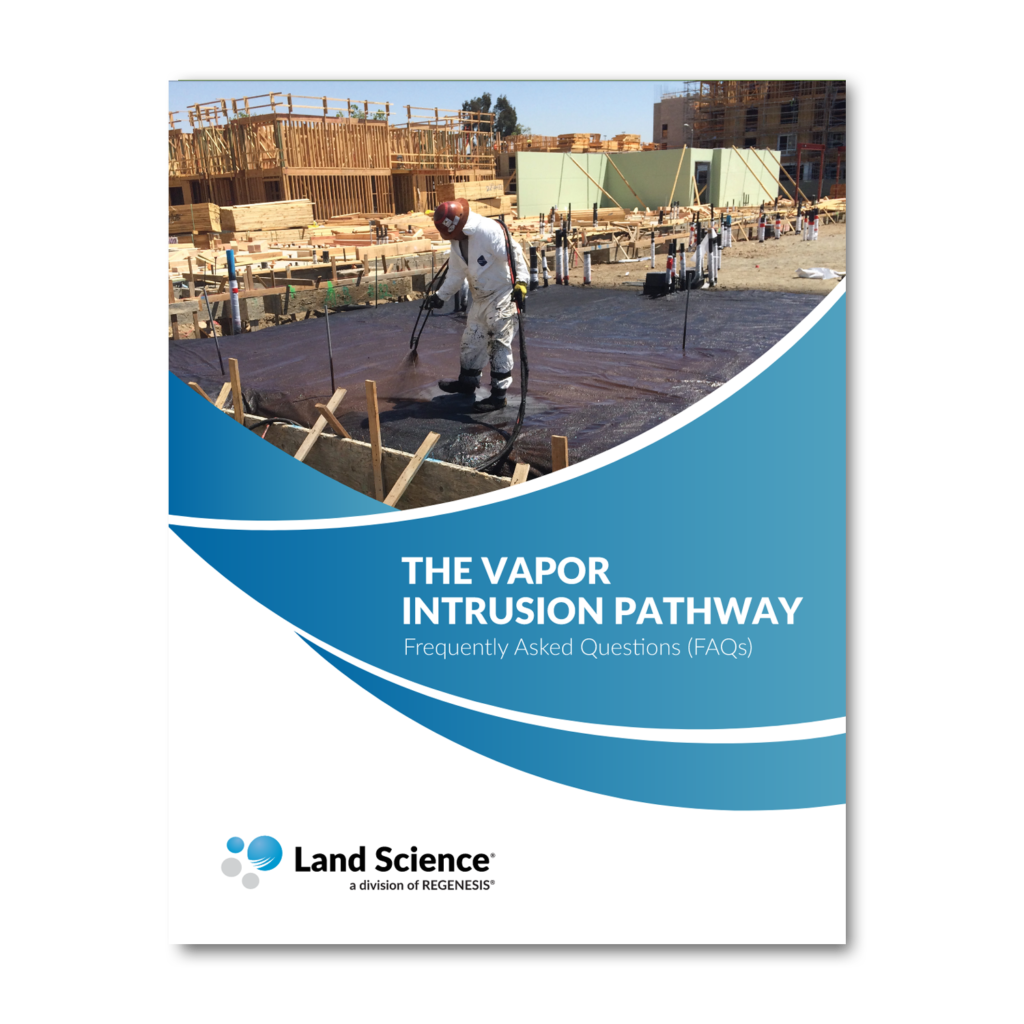Frequently Asked Questions
The following Q&A is taken from the questions posed during a Land Science webinar presentation featuring Dr. Blayne Hartman and Dr. Mark Kram in which they discussed the vapor intrusion risk pathway and the use of continuous monitoring technology.
The Vapor Intrusion Pathway
Land Science presented a webinar with vapor intrusion (VI) experts, Dr. Blayne Hartman of Hartman Environmental and Dr. Mark Kram of Groundswell Technologies. During this webinar presentation, Drs. Hartman and Kram discussed updates regarding VI pathway issues, as well as the use of continuous monitoring data. Vapor intrusion continues to be a hot topic among environmental practitioners and represents an opportunity in the industry for firms to expand in providing informed and proper VI guidance and best practices for their clients’ sites.

Blayne Hartman, PhD
President, Hartman Environmental Geoscience

Mark Kram, PhD
Founder and CTO, Groundswell Technologies
Q. What are the key questions for most VI investigations and how are they addressed?
A. The following are the key questions for most VI investigations:
- Do I have an indoor exceedance?
- If “Yes”, is this from an indoor source or due to VI?
- If due to an indoor source, can we identify this and resolve the issue?
- If due to VI, where is it coming into the structure?
We answer each of these questions within a few days of monitoring combined with a few discrete samples. As such, once you have this data in hand, you can proceed to the next step of either mitigation or site closure.
Q. In a specific example given during the presentation, a furniture facility had daytime TCE increases. Were you able to determine why TCE was not listed on the adhesive spray cans? Was it simply because TCE was present at less than 1% of formulation, and thus not required to be listed? Is it common for products to contain TCE and not report this?
A. We were not able to determine why TCE was not listed. TCE was not listed on the MSDS either. We’ve encountered similar situations with other materials. For instance, we recently encountered a disinfectant in the restroom at a facility where indoor TCE was detected. The container did not mention TCE, and the MSDS stated that it included “40% additional ingredients.” After an analysis in
the field, we determined that it did contain TCE.
This is something that OSHA has not yet caught up with. Given all the products on the market that include TCE, we will continue to be vigilant about this. Having the analyzer on-site has helped, as we were able to resolve the issues while in the field without having to wait for a fixed laboratory result.
Q. Have you found that in climates with large seasonal variations it is necessary to return to the site during different seasons to account for vapor intrusion variations? (i.e. A/C vs. heating season)
A. Since we can track conditions continuously, the consultants we have worked with have observed the initial data generated including spatial and temporal patterns, and then intentionally induced building manipulations to evaluate cause-andeffect. This includes turning the HVAC on and off, covering drains, sealing cracks, and tracking differential pressure, which is the main driver for concentration
“spikes”. With these observations, consultants have been able to convince their regulators to move the project to the next phase in the life cycle of VI management. As such, they’ve been able to proceed based on a single mobilization.
Q. How often do regulators recommend continuous monitoring vs. summa canisters to environmental consultants for sites enrolled in regulatory programs? Is continuous monitoring becoming more prevalent?
A. Yes, continuous monitoring is becoming more prevalent as practitioners see the large benefits it offers. EPA has required it on 2 thermal remediation sites to monitor for off-gassing. MA-DEP has required it on construction sites to monitor fugitive emissions. In many cases, regulators cannot require it, but they recommend it. Every agency appreciates the data because you get hundreds to thousands of data points and can see the picture much better than from a few canister or passive data points.
Q. Is calculating an average attenuation factor by using the ratio of average indoor air divided by average subslab a more representative or realistic average than calculating the average of the paired indoor and subslab measurements, especially considering that vapor migration is often deflected laterally under a slab?
A. Both methods are flawed. At sites we have monitored both sub-slab and indoor air and we see large variations in the indoor air but little variation in the sub-slab. This does not provide actionable data to find a remedy. When using our system, the data shows what is really going on which allows you to take immediate actions to find remedies.
Q. Blayne mentioned the use of radon as the indicator of VI or as the tool for attenuation factor estimation. Could you say a little more about your experience of using radon as an indicator, please?
A. Radon gives a much more realistic value for the attenuation factor than the ultra-conservative default value of 0.03. I collect radon data whenever I do sub-slab sampling.
Q. Does the enhanced monitoring show any helpful data for site specific attenuation factors? Regulators tend to suggest that attenuation factors can change over time.
A. Yes, it would show repeated measurements of both indoor air & sub-slab soil gas so that one can see if they change together. We have not done many sites with both indoor air & sub-slab data, but the limited data to date clearly shows that indoor air fluctuates much more than sub-slab soil gas, hence the attenuation factor is not constant.
Q. Is the continuous monitoring system from Groundswell Technologies available for petroleum, for example, BTEX sites?
A. It can be used on BTEX sites. We have to be careful with BTEX sites that we can get resolution of benzene or speciation of benzene from cyclohexane, but yes, it can.
Q. Is the continuous monitoring system from Groundswell Technologies system suitable for residential buildings?
A. Yes, Groundswell Technologies has used the system on residences. Quite often, it’s too expensive to use on a single residence, but in the pictures Mark showed, they were in a neighborhood, they were able to run tubing to several residences, three or four or five at one time, so that made it cost-effective. We’ve also been in large residences with lots of rooms where it was cost-effective. So yes, we have done residences, but most often, we do commercial structures.
Q. Is Land Science working on any vapor barrier technologies that can work for mercury?
A. The barriers that Land Science provides, especially the metalized films, are performing at such a high level for preventing vapor intrusion that we’re taking it to that next level in taking a third-party lab to do the analysis for mercury. And we’re confident, once we get the data back, that we’ll be able to provide that quantitative information for regulatory approval or just industry requirements. But in the interim, we do have an internally published letter that we can provide indicating why TerraShield and MonoShield would be viable barriers for mercury vapor intrusion.
Q. Please explain the use of radon sampling. Is Hartman Environmental Geoscience using it to calculate attenuation factors for use with VOCs and have you had regulatory approval, specifically in California for this?
A. With regulatory agencies, some accept it and some don’t. As far as California goes, two members of DTSC gave presentations on it recently, and in both those presentations, they said radon would be a good line of evidence to use to determine a slab-specific building specific attenuation factor. I don’t know the policy of the water boards, whether they do or don’t agree. My recommendation to practitioners is collect the radon data anyway, it’s very inexpensive. It’s another line of evidence that you can use. Some agencies or cubicles may agree with it, some may not, but it’s so inexpensive to collect. It’s worth doing so and it’s certainly better than using a default 0.03.
Q. Has the continuous monitoring system from Groundswell Technologies been installed in sub-slab or soil gas applications as opposed to just indoor air?
A. Yes, it has. What we do is we oftentimes are asked to look at the sub-slab at the same time as indoors. Obviously, in the sub-slab, we would expect a higher concentration, and so we may try to run a blank before we start to monitor indoors following a sub-slab sample, but yes, we do that.
Q. Regarding vapor barriers, is a 20 HDPE barrier still considered protective or should 40-mil barrier be used?
A. Several years ago, the U.S. EPA issued a memorandum and a lot of state regulatory have also followed suit to an extent. With 30 mils, both on the construction aspect and scientific aspect for diffusion, has been identified to be the more appropriate barrier minimum, and that’s one of the reasons why Land Science developed MonoShield, and when we designed it, we released it as a 30-mil barrier, meeting not only the construction standard, the integrity of being able to hold up to the construction of the building, but also diffusion tests, the solution being 30 mils or thicker.
The other thing they need to think about is if you’re looking or considering 20 mils, you have to think about how protected are you with the seams. A lot of the 20-mil systems out there are taped together. And if you’re only as successful as your weakest link, the tape is your weakest link, and you may still have a concern with tapes in the 20 mils.
Q. With the continuous monitoring system from Groundswell Technologies, how do you proceed if you’re sampling indoor air for PCE, TCE and vinyl chloride from impacted groundwater, but the facility uses various VOC products, so you know the VOCs are in the air? Can you keep a low reporting limit for vinyl chloride, or does the abundant VOCs in the air mask the vinyl chloride, and erase the recordings if it’s too high?
A. Not at all, because the analytical system brings in samples from the outside and does not see any air from the inside unless you want to monitor some inside rooms. The system brings in the air through the tubing. Now, if indeed in the building itself, the whole building has VOCs and you’re trying to resolve it from, say, subsurface VOCs, then the key there is to look at the ratios. And Mark showed you one example, the furniture example, where we had sub-slab data that had both TCE and PCE, but in the indoor air, we only had TCE. Well, if it was coming from vapor intrusion from the subsurface, we should have had both. So we’ve had, I would say five or so cases, where by looking at the ratio of what’s below, a compound ratio, and comparing it to what we’re seeing inside, we were able to resolve the fact that it was coming from indoor versus sub-slab or the reverse.
Q. Can the continuous monitoring system from Groundswell Technologies be used for methane monitoring only and have an alert system set up?
A. Yes, it can. And the alerts can be set up to be universal, meaning that say that you want to look at 10% of the LEL anywhere, or you can look at a specific location, you can set up a different rule for that. So it’s very flexible the way it’s been designed. Also, that the system can measure very, very low, down to the ppm level, or can measure very high, up at the percent level.
Q. Can any of the vapor barrier barrier products Land Science offers be applied over an existing floor or does the existing floor need to be removed, the barrier applied to the subfloor concrete base?
A. Yes. The Retro-Coat vapor intrusion coating from Land Science is applied to the concrete itself. It is not just painted on though. It is a process where we scarify the concrete. So we do encourage that if you have a site where you’re looking at possibly putting a barrier on top of the concrete that we do a site walk and one of our certified applicators can go through that process with you. The other barriers can go on top of a concrete; however they are not designed to be left exposed. So if we are going to use the other sub-slab barriers, we have installed, in some cases, the barrier over a concrete slab, but then a protective concrete slab has to be installed over the top of that. But we would first look at look at using Retro-Coat as a solution.


